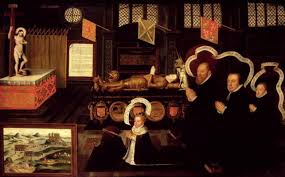Margaret Douglas: Life Story
Chapter 20 : Grief
When the news reached London of Darnley’s death, Elizabeth was sufficiently moved by compassion for Margaret to send Mildred, Lady Cecil, and Margaret, Lady William Howard (sister-in-law to the Lord Thomas who had been Margaret’s first love), to break the news to her. At the time, it was thought that Lennox, too, had been killed, and Margaret was prostrate with grief. Sir William Cecil visited her in person to reassure as to Lennox still being alive, but Margaret was in such a state that Elizabeth was recommended to release her.
Although Margaret and Elizabeth had never been close, the Queen felt genuine compassion, and had Margaret conveyed to Sheen again, where she was reunited with her son, Charles.
Lennox and Margaret were both anxious their son should be avenged, and they believed that the less-than-enthusiastic prosecution of enquiries by Queen Mary indicated her complicity. Lennox harangued Queen Mary, and, with her permission, brought a private prosecution against the Earl of Bothwell, who was acquitted. This was fuel on the fire of the Lennoxes’ suspicions.
In April 1567, Lennox returned to England, to try to comfort the grieving Margaret. Many of Elizabeth’s courtiers were moved by their sorrow, and suggested that she should ameliorate Margaret’s punishment. Eventually, the couple were allowed to live at Coldharbour, one of the lesser London palaces, but the incomes from their estates were still kept in the hands of the Crown.
Despite being strapped for cash, Margaret and Lennox commissioned a painting, known as the Memorial of Lord Darnley – of which both the original and an adapted copy survives (see image below). Aged 49 and 50, although they were not old, even by Elizabethan standards, the couple were certainly on the cusp of old age, and were concerned they might not live long enough to remind their grandson, James, of the need for vengeance. The painting makes it abundantly clear that they believed Queen Mary to be involved, if not actually the prime mover.

Margaret and Lennox were not the only people who believed Mary to be guilty, and her marriage, whether willing or not, to Bothwell sealed her fate. She was forced to abdicate in favour of her son, James, Margaret’s grandson, and was finally overthrown at the Battle of Langside in 1568. Escaping to England, Mary threw herself on Elizabeth’s mercy.Margaret and Lennox were appalled – fearful lest Mary be returned to her throne at the head of an English army. They raced to court and begged Elizabeth for justice. Margaret is described as having a face ‘swelled and stained with tears.’
Initially sympathetic, Elizabeth eventually became fed up with their grief and sent them away, saying they should not believe so great a crime of a Queen without more proof. Mary wrote indignantly to the Queen, complaining that she would see those who accused her of the crime, but would not meet Margaret herself. In Scotland, the baby James was crowned, and his uncle, Mary’s illegitimate half-brother, the Earl of Moray, ruled as Regent, bringing James up in the Protestant faith.
Over the next two years Margaret and Lennox continued to proclaim Mary’s guilt, but the matter was never resolved. Elizabeth would not take punitive action against an anointed Queen, but nor would she permit Mary to leave captivity.In 1570, the Regent Moray was assassinated. With Scotland in turmoil again, both Margaret and Queen Mary were terrified that something would happen to James. Margaret begged that Elizabeth should have James brought to England, preferably to be brought up by herself.Elizabeth would never have permitted Margaret to have James in her care – first, she would probably have tried to bring him up as a Catholic, and second, with the Queen’s nearest male heir in her hands, she might present a danger.
At the same time, Mary wrote to Margaret, saying she had not previously been in correspondence with her, because she was knew that Margaret had been accusing her ‘against [her] innocency.’ She asked Margaret’s advice on whether James should be sent to England, although she would have preferred him to be sent further afield. Margaret did not (so far as is known) reply, but reiterated her belief in Mary’s guilt in a letter to Sir William Cecil.
With Moray dead, there was confusion in Scotland, and a new regent was needed. After some humming and hawing, Elizabeth agreed that Lennox should be sent to Scotland to take over the government – obviously on the proviso that he carried out her instructions to the letter. Margaret and Charles were to stay behind, in London. Whilst no-one would have mentioned the word ‘ hostage’ there cannot have been any doubt that that was Margaret’s role.
Lady Margaret Douglas
Family Tree








